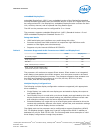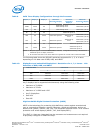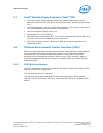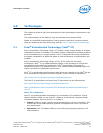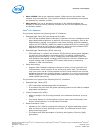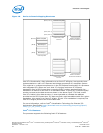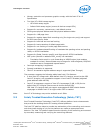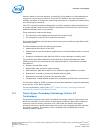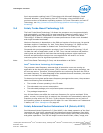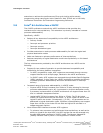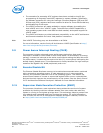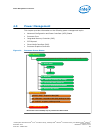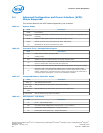
• Memory controller and processor graphics comply with the Intel VT-d 1.2
Specification
• Two Intel VT-d DMA remap engines
— iGFX DMA remap engine
— Default DMA remap engine (covers all devices except iGFX)
• Support for root entry, context entry, and default context
• 39-bit guest physical address and host physical address widths
• Support for 4 KB page sizes
• Support for register-based fault recording only (for single entry only) and support
for MSI interrupts for faults
• Support for both leaf and non-leaf caching
• Support for boot protection of default page table
• Support for non-caching of invalid page table entries
• Support for hardware-based flushing of translated but pending writes and pending
reads, on IOTLB invalidation
• Support for Global, Domain specific, and Page specific IOTLB invalidation
• MSI cycles (MemWr to address FEEx_xxxxh) not translated
— Translation faults result in cycle forwarding to VBIOS region (byte enables
masked for writes). Returned data may be bogus for internal agents; PEG/DMI
interfaces return unsupported request status
• Interrupt remapping is supported
• Queued invalidation is supported
• Intel VT-d translation bypass address range is supported (Pass Through)
The processor supports the following added new Intel VT-d features:
• 4-level Intel VT-d Page walk: Both default Intel VT-d engine, as well as the IGD
Intel VT-d engine, are upgraded to support 4-level Intel VT-d tables (adjusted
guest address width 48 bits)
• Intel VT-d superpage: support of Intel VT-d superpage (2 MB, 1 GB) for the
default Intel VT-d engine (that covers all devices except IGD)
IGD Intel VT-d engine does not support superpage and BIOS should disable
superpage in default Intel VT-d engine when iGFX is enabled.
Note: Intel VT-d Technology may not be available on all SKUs.
Intel
®
Trusted Execution Technology (Intel
®
TXT)
Intel Trusted Execution Technology (Intel TXT) defines platform-level enhancements
that provide the building blocks for creating trusted platforms.
The Intel TXT platform helps to provide the authenticity of the controlling environment
such that those wishing to rely on the platform can make an appropriate trust
decision. The Intel TXT platform determines the identity of the controlling environment
by accurately measuring and verifying the controlling software.
3.2
Technologies—Processor
Desktop 4th Generation Intel
®
Core
™
Processor Family, Desktop Intel
®
Pentium
®
Processor Family, and Desktop Intel
®
Celeron
®
Processor Family
December 2013 Datasheet – Volume 1 of 2
Order No.: 328897-004 43



